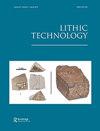Characteristics of Lithic Sound to Assess a Rock’s Predictability of Flaking
IF 1.2
3区 社会学
Q2 ANTHROPOLOGY
引用次数: 1
Abstract
ABSTRACT It has been suggested that a lithic resource’s candidacy for predictability of fracture when knapped, and whether or not a stone has been heat treated, can be assessed by the duration, pitch, and loudness of sound made when a stone is struck. A hammer stone machine held and struck specimens of 16 lithic types. Acoustic information was processed with a Kay Computer Speech Laboratory. Differences exist in sound duration, pitch and loudness between lithic types, un-heat-treated and heat-treated stone, and stone of the same type but of high and of low quality. Heat treated samples conduct sound waves of longer duration than unheated samples, and heat-treated samples’ sounds were louder than un-heat-treated samples. An ancient knapper could use perceptible differences in sound produced by a nodule when tapped with a hammerstone to select or discard nodules or flakes of one lithic type over another based on anticipated predictability of flaking.评估岩石剥落可预测性的岩石声音特征
摘要有人提出,可以通过石头被撞击时发出的声音的持续时间、音调和响度来评估石头资源在被撞击时断裂的可预测性,以及石头是否经过热处理。一种锤石机,用于盛放和敲击16种石器类型的标本。声学信息由Kay计算机语音实验室处理。石器类型、未经热处理和热处理的石头以及相同类型但质量高和低的石头之间在声音持续时间、音高和响度方面存在差异。热处理后的样品比未加热的样品传导更长时间的声波,并且热处理后样品的声音比未热处理的样品更大。一个古老的敲击者可以利用用锤石敲击结节时产生的可察觉的声音差异,根据预期的剥落可预测性,选择或丢弃一种石器类型的结节或薄片。
本文章由计算机程序翻译,如有差异,请以英文原文为准。
求助全文
约1分钟内获得全文
求助全文

 求助内容:
求助内容: 应助结果提醒方式:
应助结果提醒方式:


